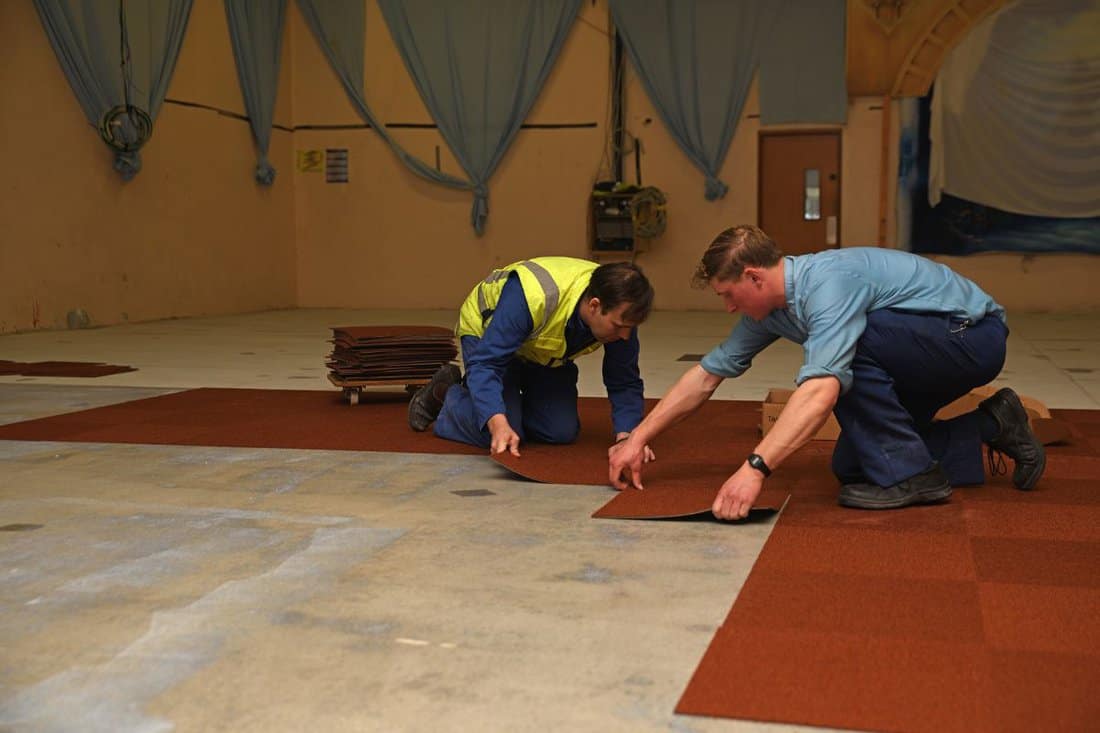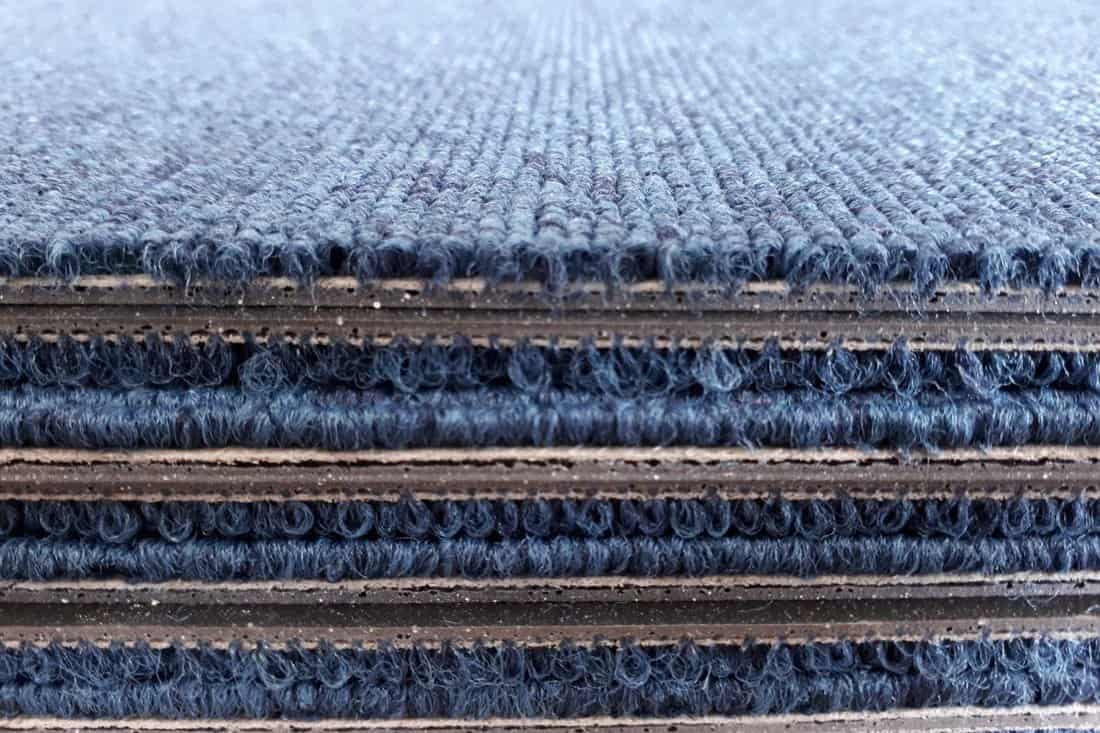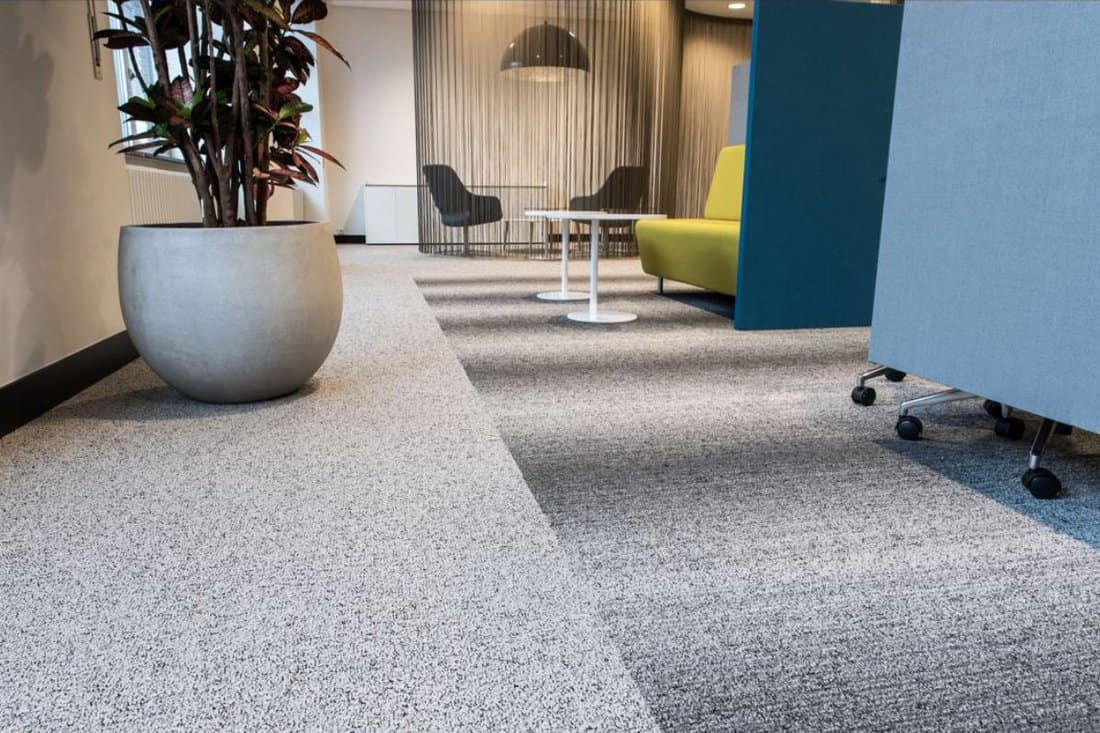Flooring is a crucial component that will influence the outcome of your home regardless of whether you're remodeling or planning it from scratch. Have you thought of using carpet tiles but have no idea if they're worth it?
But what potential benefits and drawbacks could there be for carpet tiles? To provide you with some insight, we did extensive research into these popular tiles.
The pros of carpet tiles include:
- Adaptable and robust
- Simple installation and upkeep
- Affordable and long-lasting
On the other hand, its cons include:
- Loose or fraying fibers
- Appearance could not be uniform
- It could be installed improperly
Numerous households prefer carpeting, particularly carpet tiles, primarily due to how simple they are to use and maintain. Carpet tiles can completely change a home, even with simple wall and ceiling treatments. With that said, let's dive right into this post!
![carpet tile surface texture pattern close up grey tone perspective view with sun ray over selective focus. - Carpet Tiles Pros And Cons [For Home Use]](https://homedecorbliss.com/wp-content/uploads/2022/09/carpet-tile-surface-texture-pattern-close-up-grey-tone-perspective-view-with-sun-ray-over-selective-focus.-Carpet-Tiles-Pros-And-Cons-For-Home-Use.png)
Carpet Tiles: Pros
Workplaces, rooms, passageways, and living spaces feature carpet tiles.
Let's now examine the reasons behind their rise to fame. If installing carpet tiles in your home is something you want, it's always good to know the possibilities.
Carpet Tiles Go With Just About Anything
We sometimes add affiliate links and content that was curated and created by our team with the help of advanced ai tools to help showcase the best design styles.

The adaptability of carpet tiles is one of their main benefits. There are many different sizes, textures, and colors available. They are also excellent for awkwardly shaped rooms and difficult-to-reach locations.
Furthermore, these tiles are ideal for home settings with limited space. Another well-liked benefit and selling aspect of carpet tile installations is their long-lasting nature.
Furthermore, when carpet tiles deteriorate, they are simple to repair. A carpet tile installation allows you to replace individual tiles as needed, unlike a typical carpet installation.
If you go with a full-blown carpet, you would need to replace it entirely.
The Installation/Upkeep Of Carpet Tiles Is Simple

The installation of carpet tiles may be more straightforward than a carpet roll, which is an excellent additional argument in favor of their use.
The handling and installation of the carpet piece are made simple by the modular tiles' reduced size.
The carpet is not stretched with a knee kicker or any other equipment. DIY pros find carpet tiles particularly enticing due to their simplicity of installation.
Cleaning carpet tiles is typically the same as cleaning regular carpets in terms of upkeep. However, using carpet tiles makes it much easier to restore a part of your carpet that is severely discolored or damaged.
Carpet Tiles Are Affordable And Long-Lasting

Due to their low waste production, small storage needs, and ease of transportation, carpet tiles are economical. The biggest cost-saving opportunity is in the installation process, which a skilled installer will complete much more quickly than they would with wall-to-wall carpet.
The relative speed of employing carpet tiles will result in less disturbance of household activities during installation, resulting in fewer associated costs.
Compared to broadloom, which is not a choice because of the wall-to-wall installation, there is virtually very little waste when installing carpet tiles because you order the tiles to match the space.
Long-term advantages include that you won't have to replace the flooring entirely if you need to replace some carpet tiles. Additionally, carpet tiles can frequently be recycled.
They might no longer fit your standards for color, design, or aesthetic quality, but they'll probably still be useful somewhere else. It is usual for carpet tiles also to be renovated and utilized in affordable or social housing.
Carpet Tiles: Cons
While carpet tiles have a lot of benefits, they also have some significant drawbacks. This does not imply that you shouldn't use carpet tiles for your flooring.
But before settling on a choice, research the many flooring options and know what to expect. The disadvantages of installing carpet tiles for your home are listed below.
There Are Loose Or Fraying Fibers In The Carpet Tiles
There are greater seams and gaps in a carpet tile installation compared to a broadloom setup of equal size for understandable reasons.
In rare cases, during or after installation, you may notice occasional fraying or loose fiber on the margins of the tiles that has happened during manufacture. However, this is a pretty simple problem to fix.
The Appearance Of Carpet Tiles May Not Be Uniform
Because of how carpet tiles are made, even with inch-perfect installation, they might not replicate the consistent appearance of broadloom carpets.
There are certain variations that approximate a broadloom look better than others. Even though machines manufacture most carpet tiles, some variability is always possible.
Although they fit together nicely, they don't have the same cohesiveness as a broadloom carpet. However, this problem is minimal and frequently goes unnoticed.
Carpet Tiles Might Be Installed Improperly
Although carpet tiles are simple to install, it is crucial to adhere to the manufacturer's instructions. One need that is occasionally disregarded, frequently for pragmatic reasons, is acclimatization.
Tiles not adequately acclimated to their new environment may start to "move" after placement.
As a result, the seams in between tiles could become more apparent, or even the center or edges of the tiles may rise above the surface.
When the differences between the room temperatures inside and outside are the greatest, this issue is more likely to arise. The directions on attaching carpet tiles to the subfloor must also be understood for similar reasons.
While certain tiles were self-adhesive or used specific bonding techniques, the tacky adhesive is typically utilized, which guarantees the tiles' stability in the lateral plain while allowing for the lifting and removal of tiles.
Detailed information must be sought out and followed because suggestions on adhesive and application may differ from manufacturer to manufacturer.
Check out this carpet tile on Amazon.
How Long Will Carpet Tiles Last?

You may be interested in learning how long carpet tile lasts.
Some factors that impact how long carpet tiles survive include the caliber of the materials, the installation technique, the area of use, the type of maintenance, and the performance time.
Depending on how well they are maintained, carpet tiles can last anywhere from 8 to 20 years.
The flooring is given top consideration while remodeling a property. Carpet tiles are the best option for a home's flooring.
This is due to their superior streetscape, sustainability, affordability, and ease of maintenance compared to other materials. For many consumers, carpet tiles are a common option for hardwood flooring.
There has been enormous growth in the carpet tile market. It is well-liked since it is inexpensive, simple, and clean.
What Are Carpet Tiles Made Of?

All carpets are not created equal. Several fibers can be used to make them, impacting how the mat feels, performs, and is durable. A list of several of the most popular carpet fibers is provided below.
Nylon Carpet Tile
The most common carpet material is nylon. Why? Due to its toughness, static-free nature, and frequent stain-blocking treatment. It continues to look wonderful. This is perfect for indoor use.
Polyester Carpet Tile
Consider polyester if you're looking for a much more environmentally friendly material. Most of the materials used to make it are recycled.
Additionally, it is virtually as durable and a little cheaper than nylon. This fiber has the broadest range of colors and the best stain and fades resistance.
Polypropylene Carpet Tile
This fiber doesn't fade or become stained quickly since the color is infused throughout the material rather than applied only to the surface.
Polypropylene is flexible and strong, but if it isn't correctly cared for, it can collect oil, giving it a dingy appearance.
To Wrap Things Up
Carpet tiles have a lot of advantages, but they also have some drawbacks. After collecting all this data, you may decide whether to purchase this carpet flooring.
If you do decide to put carpet tiles in your home, take the time to educate yourself on the various carpet types and choose which ones would best suit your needs.
Invest the necessary time in thorough research, acquire the best resources possible, and never be afraid to ask for help from experts.
By following the instructions, you may make a beautiful carpeted floor that looks fantastic and lasts a very long time.
Before you go, here are related articles you may want to read:
10 Best Glues And Adhesives For Carpet Tiles

